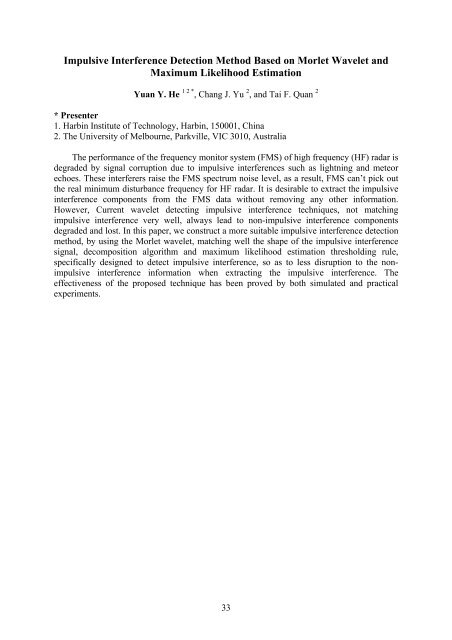Workshop proceeding - final.pdf - Faculty of Information and ...
Workshop proceeding - final.pdf - Faculty of Information and ...
Workshop proceeding - final.pdf - Faculty of Information and ...
You also want an ePaper? Increase the reach of your titles
YUMPU automatically turns print PDFs into web optimized ePapers that Google loves.
Impulsive Interference Detection Method Based on Morlet Wavelet <strong>and</strong><br />
Maximum Likelihood Estimation<br />
Yuan Y. He 1 2 * , Chang J. Yu 2 , <strong>and</strong> Tai F. Quan 2<br />
* Presenter<br />
1. Harbin Institute <strong>of</strong> Technology, Harbin, 150001, China<br />
2. The University <strong>of</strong> Melbourne, Parkville, VIC 3010, Australia<br />
The performance <strong>of</strong> the frequency monitor system (FMS) <strong>of</strong> high frequency (HF) radar is<br />
degraded by signal corruption due to impulsive interferences such as lightning <strong>and</strong> meteor<br />
echoes. These interferers raise the FMS spectrum noise level, as a result, FMS can’t pick out<br />
the real minimum disturbance frequency for HF radar. It is desirable to extract the impulsive<br />
interference components from the FMS data without removing any other information.<br />
However, Current wavelet detecting impulsive interference techniques, not matching<br />
impulsive interference very well, always lead to non-impulsive interference components<br />
degraded <strong>and</strong> lost. In this paper, we construct a more suitable impulsive interference detection<br />
method, by using the Morlet wavelet, matching well the shape <strong>of</strong> the impulsive interference<br />
signal, decomposition algorithm <strong>and</strong> maximum likelihood estimation thresholding rule,<br />
specifically designed to detect impulsive interference, so as to less disruption to the nonimpulsive<br />
interference information when extracting the impulsive interference. The<br />
effectiveness <strong>of</strong> the proposed technique has been proved by both simulated <strong>and</strong> practical<br />
experiments.<br />
33
















